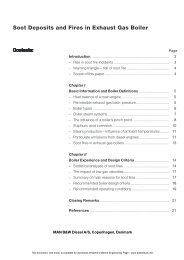Fuel Cells - Green Power - Martin's Marine Engineering Page
Fuel Cells - Green Power - Martin's Marine Engineering Page
Fuel Cells - Green Power - Martin's Marine Engineering Page
- No tags were found...
You also want an ePaper? Increase the reach of your titles
YUMPU automatically turns print PDFs into web optimized ePapers that Google loves.
Other Types of PolymerElectrolyte Membrane<strong>Fuel</strong> Cell SystemsThere are several other types of polymer electrolytemembrane fuel cells for transportation applications,although none have reached the same stage of developmentand simplicity as the hydrogen/air.Reformate/Air <strong>Fuel</strong> CellComputer model of 50kW fuel cell stack with reformer.(Courtesy: International <strong>Fuel</strong> <strong>Cells</strong>)Processing Hydrocarbon <strong>Fuel</strong>s into HydrogenAs long as hydrogen is difficult to store on a vehicle, on-boardfuel processors will be needed to convert a hydrocarbon fuel,such as methanol or gasoline, to a H 2 rich gas for use in the fuelcell stack. Currently, steam reforming of methanol to H 2 is theconventional technology, although partial oxidation of gasoline toH 2 is attractive because of the gasoline infrastructure already inplace in most countries. Both types of fuel processors are complexsystems.The steam reforming of methanol involves the reaction of steamand pre-vaporized methanol at 200˚C (gasoline requires temperaturesover 800˚C) to produce a mixture of H 2 , carbon dioxide(CO 2 ), carbon monoxide (CO), and excess steam. This mixturepasses through another reactor, called a shift reactor, which usescatalysts and water to convert nearly all of the CO to CO 2 as wellas additional H 2 . There can be a third stage in which air is injectedinto the mixture in a third type of reactor, the preferentialoxidation reactor. Oxygen in the air reacts with the remaining COover a Pt-containing catalyst to convert CO to CO 2 . The final gasmixture contains about 70% H 2 , 24% CO 2 , 6% nitrogen (N 2 )and traces of CO.In addition to the direct hydrogen fuel cell, research iscurrently underway to develop a fuel cell system thatcan operate on various types of hydrocarbon fuels —including gasoline, and alternative fuels such as methanol,natural gas, and ethanol. Initially, this fuel-flexiblefuel strategy will enable reformate/air fuel cell systemsto use the exisiting fuels infrastructure. A hydrogen/airpolymer electrolyte membrane fuel cell would be fueledfrom an onboard reformer that can convert these fuelsinto hydrogen-rich gas mixtures. Processing hydrocarbonfuels to generate hydrogen is a technical challengeand a relatively demanding operation.Hydrocarbon fuels require processing temperatures of700˚C - 1000˚C. Sulfur, found in all carbon-based fuels,and carbon monoxide generated in the fuel processor,must be removed to avoid poisoning the fuel cellcatalyst. Although the reformate/air fuel cell lacks thezero emission characteristic of the direct hydrogen fuelcell, it has the potential of lowering emissions significantlyvs. the gasoline internal combustion engine. Thenear-term introduction of reformate/air fuel cells isexpected to increase market acceptance of fuel celltechnology and help pave the way for the widespreaduse of direct hydrogen systems in the future.With the partial oxidation reformer system, liquid fuel is firstvaporized into a gas. The gas is then ignited in a partial oxidationreactor which limits the amount of air so that primarily H 2 , COand CO 2 are produced from the combustion. This mixture ispassed through a shift reactor to convert the CO to CO 2 and thenthrough a preferential oxidation reactor to convert any remainingCO to CO 2 . Conventional partial oxidation takes place at~1000˚C and catalytic partial oxidation takes place at ~700˚C.The final reformate composition is about 42% N 2 , 38% H 2 ,18% CO 2 , less than 2% CH 4 and traces of CO.This document, and more, is available for download at <strong>Martin's</strong> <strong>Marine</strong> <strong>Engineering</strong> <strong>Page</strong> - www.dieselduck.net15

















